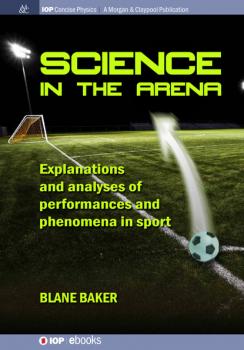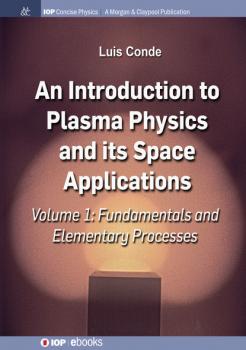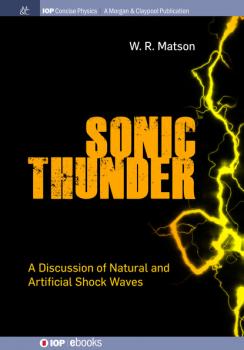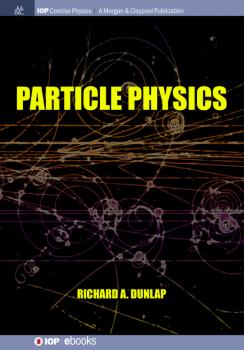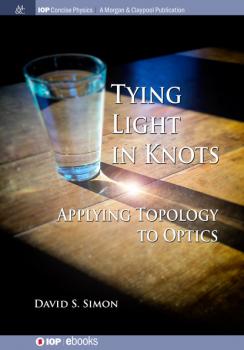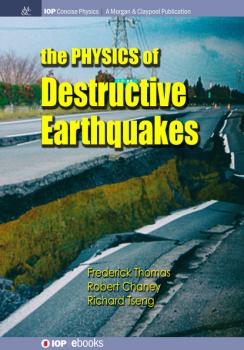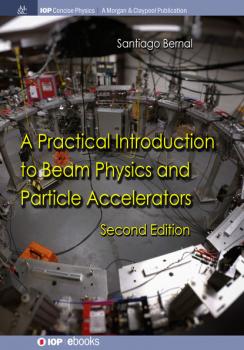ТОП просматриваемых книг сайта:
Физика
Различные книги в жанре Физика, доступные для чтения и скачиванияАннотация
The arena of sport is filled with marvelous performances and feats that, at times, seem almost beyond belief. As curious onlookers, we often wonder whether or not athletes will reach certain peaks and what determines their limits of athletic performance. Science, with its emphasis on theoretical development and experimental results, is uniquely equipped to answer these kinds of questions. Over the past two decades, I have been asked innumerable questions related to how science can provide these kinds of insights. Science in the Arena is written as an outgrowth of those interactions with the primary goal of communicating useful and understandable scientific explanations of athletic performance.
An Introduction to Plasma Physics and Its Space Applications, Volume 1 - Luis Conde
IOP Concise PhysicsАннотация
The growing number of scientific and technological applications of plasma physics in the field of Aerospace Engineering requires that graduate students and professionals understand their principles. This introductory book is the expanded version of class notes of lectures I taught for several years to students of Aerospace Engineering and Physics. It is intended as a reading guide, addressed to students and non-specialists to tackle later with more advanced texts. To make the subject more accessible the book does not follow the usual organization of standard textbooks in this field and is divided in two parts. The first introduces the basic kinetic theory (molecular collisions, mean free path, etc.) of neutral gases in equilibrium in connection to the undergraduate physics courses. The basic properties of ionized gases and plasmas (Debye length, plasma frequencies, etc.) are addressed in relation to their equilibrium states and the collisional processes at the microscopic level. The physical description of short and long-range (Coulomb) collisions and the more relevant collisions (elementary processes) between electrons' ions and neutral atoms or molecules are discussed. The second part introduces the physical description of plasmas as a statistical system of interacting particles introducing advanced concepts of kinetic theory, (non-equilibrium distribution functions, Boltzmann collision operator, etc). The fluid transport equations for plasmas of electron ions and neutral atoms and the hydrodynamic models of interest in space science and plasma technology are derived. The plasma production in the laboratory in the context of the physics of electric breakdown is also discussed. Finally, among the myriad of aerospace applications of plasma physics, the low pressure microwave electron multipactor breakdown and plasma thrusters for space propulsion are presented in two separate chapters.
Аннотация
Since the earliest days of human existence, the clash of thunder and trembling of the hills has struck fear into the hearts of seasoned warriors and tribal villagers alike. Great gods, demi-gods, and heroes were created to explain the awesome, mysterious, and incomprehensibly powerful forces of Nature in a feeble attempt to make sense of the world around them. To our advanced scientific minds today, these explanations seem childish and ridiculous; however, the power to flatten thousands of square miles of ancient forest, create massive holes in the Earth itself, and cause mountains to tremble to their very roots are more than enough reason to believe. Indeed, perhaps our scientific advancement has caused us to not fully or completely appreciate the awesome scale and power that Nature can wield against us. The study of shock wave formation and dynamics begins with a study of waves themselves. Simple harmonic motion is used to analyze the physical mechanisms of wave generation and propagation, and the principle of superposition is used to mathematically generate constructive and destructive interference. Further development leads to the shock singularity where a single wave of immense magnitude propagates and decays through various media. Correlations with the fields of thermodynamics, meteorology, crater formation, and acoustics are made, as well as a few special applications. Direct correlation is made to events in Arizona, Siberia, and others. The mathematical requirement for this text includes trigonometry, differential equations, and large series summations, which should be accessible to most beginning and advanced university students. This text should serve well as supplementary material in a course covering discrete wave dynamics, applied thermodynamics, or extreme acoustics.
Аннотация
Our understanding of subatomic particles developed over many years, although a clear picture of the different particles, their interactions and their inter-relationships only emerged in the latter part of the twentieth century. The first «subatomic particles» to be investigated were those which exhibit readily observable macroscopic behavior, specifically these are the photon, which we observe as light and the electron, which is manifested as electricity. The true nature of these particles, however, only became clear within the last century or so. The development of the Standard Model provided clarification of the way in which various particles, specifically the hadrons, relate to one another and the way in which their properties are determined by their structure. The final piece, perhaps, of the final model, that is the means by which some particles acquire mass, has just recently been clarified with the observation of the Higgs boson. Since the 1970s it has been known that the measured solar neutrino flux was inconsistent with the flux predicted by solar models. The existence of neutrinos with mass would allow for neutrino flavor oscillations and would provide an explanation for this discrepancy. Only in the past few years, has there been clear experimental evidence that neutrinos have mass. The description of particle structure on the basis of the Standard Model, along with recent discoveries concerning neutrino properties, provides us with a comprehensive picture of the properties of subatomic particles. Part I of the present book provides an overview of the Standard Model of particle physics including an overview of the discovery and properties of the Higgs boson. Part II of the book summarizes the important investigations into the physics of neutrinos and provides an overview of the interpretation of these studies.
Аннотация
It was not until 1971 that the authority for defining scientific units, the General Conference of Weights and Measures got around to defining the unit that is the basis of chemistry (the mole, or the quantity of something). Yet for all this tardiness in putting the chemical sciences on a sound quantitative basis, chemistry is an old and venerable subject and one naturally asks the question, why? Well, the truth is that up until the mid-1920s, many physicists did not believe in the reality of molecules. Indeed, it was not until after the physics community had accepted Ernest Rutherford's 1913 solar-system-like model of the atom, and the quantum mechanical model of the coupling of electron spins in atoms that physicists started to take seriously the necessity of explaining the chemical changes that chemists had been observing, investigating and recording since the days of the alchemists.
Аннотация
Topology is the study of properties of geometrical objects that remain invariant as the object is bent, twisted, or otherwise continuously deformed. It has been an indispensable tool in particle physics and solid state physics for decades, but in recent years it has become increasingly relevant in classical and quantum optics as well. It makes appearances through such diverse phenomena as Pancharatnam-Berry phases, optical vortices and solitons, and optical simulations of solid-state topological phenomena. This book concisely provides the necessary mathematical background needed to understand these developments and to give a rapid survey of some of the optical applications where topological issues arise.
Аннотация
Science often deals with hard-to-see phenomena, and they only stand out and become real when viewed through the lens of complex statistical tools. This book is not a textbook about statistics applied to science – there are already many excellent books to choose from – rather, it tries to give an overview of the basic principles that physical scientists use to analyze their data and bring out the order of Nature from the fog of background noise.
Аннотация
This book is a concise introduction to the interactions between earthquakes and human-built structures (buildings, dams, bridges, power plants, pipelines and more). It focuses on the ways in which these interactions illustrate the application of basic physics principles and concepts, including inertia, force, shear, energy, acceleration, elasticity, friction and stability. It illustrates how conceptual and quantitative physics emerges in the day-to-day work of engineers, drawing from examples from regions and events which have experienced very violent earthquakes with massive loss of life and property. The authors of this book, a physics educator, a math educator, and a geotechnical engineer have set off on what might be considered a mining expedition; searching for ways in which introductory physics topics and methods can be better connected with careers of interest to non-physics majors. They selected «destructive earthquakes» as a place to begin because they are interesting and because future engineers represent a significant portion of the non-physics majors in introductory physics courses. Avoiding the extremes of treating applied physics either as a purely hands-on, conceptual experience or as a lengthy capstone project for learners who have become masters; the application in this book can be scattered throughout a broader physics course or individual learning experience.
Информация о книге
Автор произведения Frederick William Thomas
Жанр Физика
Серия IOP Concise Physics
A Practical Introduction to Beam Physics and Particle Accelerators - Santiago Bernal
IOP Concise PhysicsАннотация
This book provides a brief exposition of the principles of beam physics and particle accelerators with an emphasis on numerical examples employing readily available computer tools. However, it avoids detailed derivations, instead inviting the reader to use general high-end languages such as Mathcad and Matlab, as well as specialized particle accelerator codes (e.g. MAD, WinAgile, Elegant, and others) to explore the principles presented. This approach allows readers to readily identify relevant design parameters and their scaling. In addition, the computer input files can serve as templates that can be easily adapted to other related situations. The examples and computer exercises comprise basic lenses and deflectors, fringe fields, lattice and beam functions, synchrotron radiation, beam envelope matching, betatron resonances, and transverse and longitudinal emittance and space charge. The last chapter presents examples of two major types of particle accelerators: radio frequency linear accelerators (RF linacs) and storage rings. Lastly, the appendix gives readers a brief description of the computer tools employed and concise instructions for their installation and use in the most popular computer platforms (Windows, Macintosh and Ubuntu Linux). Hyperlinks to websites containing all relevant files are also included. An essential component of the book is its website (actually part of the author's website at the University of Maryland), which contains the files that reproduce results given in the text as well as additional material such as technical notes and movies.
Аннотация
Electrostatic forces are essential for the hierarchical structure of matter: electrons are bound to the atomic nucleus by electrostatic forces; atoms carry (partial) charges and ions with opposite charges attract and form (chemical) bonds. Small residual electrostatic forces between molecules allow them to form macroscopic structures such as crystals. Electrostatic interactions explain pseudo-forces used in popular computer programs used to model properties of atoms, molecules, and proteins. By beginning with the basics and then diving deeper into the topic, this book aims to familiarize the reader with electrostatic forces at the atomic and molecular level.

